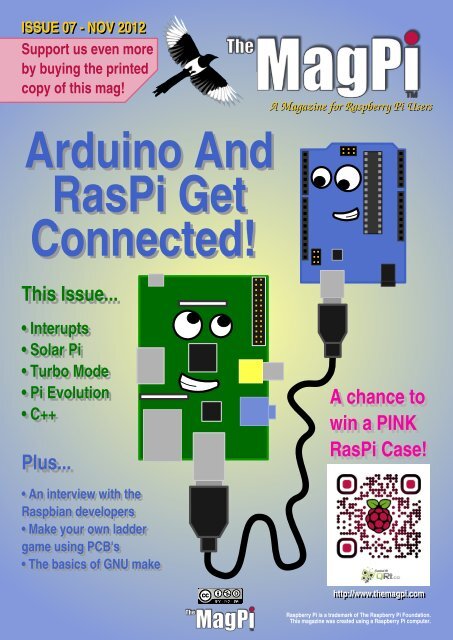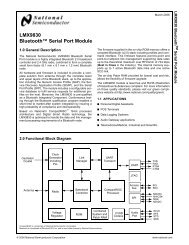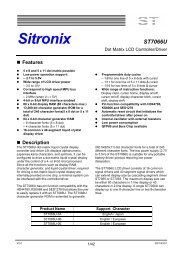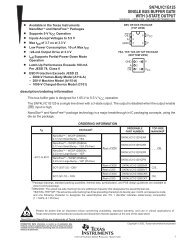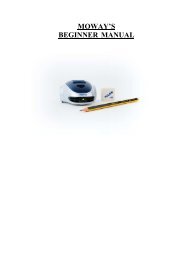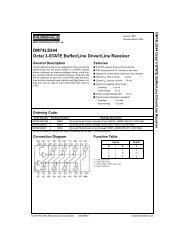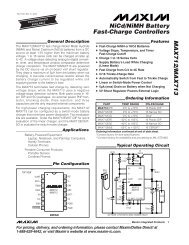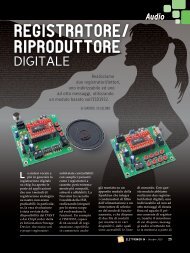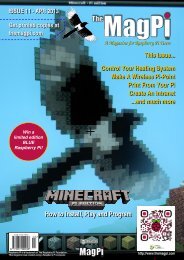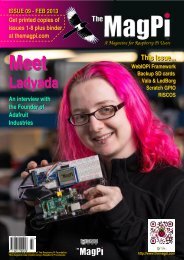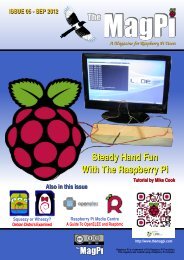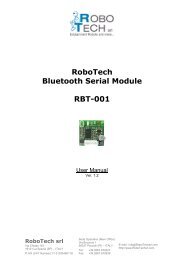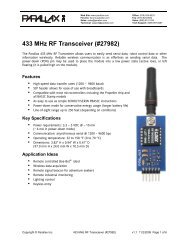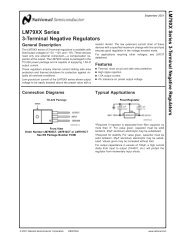The MagPi issue 7.pdf - Finalart
The MagPi issue 7.pdf - Finalart
The MagPi issue 7.pdf - Finalart
- No tags were found...
You also want an ePaper? Increase the reach of your titles
YUMPU automatically turns print PDFs into web optimized ePapers that Google loves.
IISSUE 07 - NOV 2012Support us even moreby buying the printedcopy of this mag!A Magazine for Raspberry Pi UsersArduino AndRasPi GetConnected!TT hh i ss I ss ss uu ee . . .• I nn t ee rr uu pp t ss• S oo l aa rr Pi• TT uu rr bb oo M oo dd ee• Pi E vv oo l uu t i oo nn• C ++ ++Pl uu ss . . .A cc hh aa nn cc ee t oowi nn aa PINKIR aa ssPi C aa ss ee !• A nn i nn t ee rr vv i eew wi t hh t hh eeR aa ss pp bb i aa nn dd ee vv ee l oo pp ee rr ss• M aa kk ee yy oo uu rr oow nn l aa dd dd ee rrgg aam ee uu ss i nn gg PCB ''ss• TT hh ee bb aa ss i cc ss oo f GNU m aa kk eehh t t pp : / /www / . t hh eem aa gg pp i . cc oomRaspberry Pi is a trademark of <strong>The</strong> Raspberry Pi Foundation.This magazine was created using a Raspberry Pi computer.
Welcome to Issue 7,<strong>The</strong> Raspberry Pi and Arduino are a perfect match for real time applicationswhere a bit more CPU power is needed for control. Coupling the two devicestogether opens up the possibility to use a wealth of Arduino sheilds too. We lookforward to seeing some really interesting projects in the future.<strong>The</strong>re is an interview from the lead developer of Raspbian (Debian build for theRaspberry Pi), competitions and a selection of programming articles to get yourteeth into.If you would prefer to receive your copy of <strong>The</strong> <strong>MagPi</strong> in hard copy, visithttp://www.modmypi.com and place your order now!Ash Stone, Chief Editor of <strong>The</strong> <strong>MagPi</strong>
Contents
$ sudo apt-get install arduino$ sudo apt-get install python-serial mercurial$ hg clone https://bitbucket.org/tino/pyfirmata$ cd pyfirmata$ sudo python setup.py install$ cd .. ; sudo rm -r pyfirmata
arduino_firmata_ty.py$ python arduino_firmata_tk.py
import pyfirmatafrom Tkinter import *# Create a new board object,# specifying serial port;# could be /dev/ttyUSB0 for older# Arduinosboard = pyfirmata.Arduino('/dev/ttyACM0')# start an iterator thread so# serial buffer doesn't overflowiter8 = pyfirmata.util.Iterator(board)iter8.start()# set up pins# A0 Input (LM35)pin0 = board.get_pin('a:0:i')# D3 PWM Output (LED)pin3 = board.get_pin('d:3:p')# IMPORTANT! discard first reads# until A0 gets something validwhile pin0.read() is None:passdef get_temp():# LM35 reading in deg C to labellabel_text = "Temp: %6.1f C" % (pin0.read() * 5 * 100)label.config(text = label_text)# reschedule after half secondroot.after(500, get_temp)def set_brightness(x):# set LED# Scale widget returns 0 .. 100# pyfirmata expects 0 .. 1.0pin3.write(float(x) / 100.0)def cleanup():# clean up on exit# and turn LED back offpin3.write(0)board.exit()# set up GUIroot = Tk()# ensure cleanup() is called on exitroot.wm_protocol("WM_DELETE_WINDOW",cleanup)# draw a big slider for LED brightnessscale = Scale(root,command = set_brightness,orient = HORIZONTAL,length = 400,label = 'Brightness')scale.pack(anchor = CENTER)# place label up against scale widgetlabel = Label(root)label.pack(anchor = 'nw')# start temperature read looproot.after(500, get_temp)# run Tk event looproot.mainloop()
NOVEMBER COMPETITION!Last Month's Winners!.
A Little RayOf Sunshine…While browsing for interesting Raspberry Pi devices, I cameacross the following item from CottonPickersPlace.
$ cd$ git clonegit://git.drogon.net/wiringPi$ cd WiringPi$ ./bulid$ cd$ git clonegit://git.drogon.net/ladder$ cd ladder$ ./ladderTest.sh$ ./tuxx.sh
How to share GPIO resources among multiple applications,and use of interrupts to replace wasteful status check loops.Setting Up <strong>The</strong> Pinsecho Hello there.12
echo Hello there. >file_01echo out>/sys/class/gpio/gpio23/directionecho low >/sys/class/gpio/gpio23/directionecho high>/sys/class/gpio/gpio23/directionPlease note GPIO reference changes forpins 3,5,7 & 13 on Revision 2.0echo 23 >/sys/class/gpio/exportecho 1 >/sys/class/gpio/gpio23/valueecho 0 >/sys/class/gpio/gpio23/valueecho 1 >/sys/class/gpio/gpio23/active_lowContinues on the next page13
yniker@raspberrypi:~$ gpio_control16 exportexport failed: Device or resource busy<strong>The</strong> Programgpio_control 23 export14
Expanding <strong>The</strong> GPIOAnother Python programA Summary of <strong>The</strong> URLsBy Richard Ryniker15
An interview with Mike Thompson
Mike Thompson is a Computer Engineer living inthe San Francisco Bay Area. He has a diversebackground in embedded systems design,handheld/mobile application development, PCapplication development and large scale Internetsystems design. He is a serial entrepreneur whoco-founded two previous companies and is thefounder and a lead developer for Raspbian, theleading operating system for the Raspberry Pi.
$ sudo raspi-config$ sudo raspi-config
$ sudo apt-get update$ sudo apt-get upgrade -y
PI-EVOLUTION
<strong>The</strong> basics of GNU MakeMaking code development fasteris a central part of building packages of compiled code or documentation on a LINUX system. Whenit reads one or more text files containing targets and dependencies. <strong>The</strong> targets are only executed if a file is notpresent or is newer than the output file. <strong>The</strong> syntax also allows multiple dependencies, such that some files arerequired to be built before others. Starting with a first example,runsSimilar to scripting languages, comments start with a hash or pound character (#). <strong>The</strong> targethas nospaces or tabs in front of it and is followed by a colon. Dependencies for the target can be added after the colon. <strong>The</strong>actions are given on lines after the target name and must be prefixed by a tab character. If white spaces are usedmake will report an error.By default looks for a file called . <strong>The</strong>refore, use (described in the <strong>issue</strong> 3 C cave article) tocreate a file calledcontaining the example above. <strong>The</strong>n type<strong>The</strong> first time is typed the command executes the target, which uses the command to create anempty file of the right name. <strong>The</strong> second time is typed it, it finds that the file already exists and no action isneeded.For examples with dependencies, a small C example can be used. In a new directory, create three files:and24
Now create a new file calledcontaining,This time typing make will cause each file to be compiled into a file. <strong>The</strong>n the files are linked together to forman executable called . <strong>The</strong> target is the first target in the file and is therefore the defaulttarget. When runs it checks the dependencies of , which are that the andfiles exist and are not newer than the target. If the files do not exist then the target tomake the file is run. Any target other than the default target can be run by typing the target name after thecommand, e.g.Writing files where each of the file names needs to be specified can rapidly become very time consuming.Automatic variables can be used instead of explicitly specified targets,This has exactly the same as action as the previous one. <strong>The</strong> automatic variable is the target name,are the names of all of the dependencies, and is the name of the first prerequisite. For each file required by thedefault target, make tries the wildcard . If the file is missing make will report an error.Wildcards can also be used to define a list of objects from the list offiles in the present working directory,where is a variable. In this case, all of the files in the present working directory are used to build anexecutable called . <strong>The</strong> command lists all files which match the pattern . <strong>The</strong>nremoves the ending an replaces it with . <strong>The</strong> resulting list is assigned to the variable. Try usingto update each file time stamp and then re-run make to see what happens.files can have many layers of dependencies. For software distribution on multiple platforms, the Makefiles aretypically generated from templates using thetool.Article by W. H. Bell25
#include using namespace std;int main(){//Output a message.cout
#include using namespace std;int main(){//Create 2 variablesint a, b;a = 1;b = 2;}//Output the sum of these variablescout
python lines.py -hpython lines.py -s 3 -t 4# line generator with command line arguments# By Colin Deady - 03 October 2012import os, pygame, argparse, sysfrom pygame.locals import *# initialise pygame (to render the image)pygame.init()# Define two functions that will be used:# 1) fnAppend2Log will write a line to a log filedef fnAppend2Log( line2write ):logfile = open('lines.log', 'a')logfile.write(line2write + '\n')logfile.close()# 2) fnPlotLines will render a quarter of the shape.# Uses the previous co-ordinates as the new starting co-ordinatesdef fnPlotLines(quarter, sX, sY, eX, eY, incSX, incSY, incEX, incEY ):fnAppend2Log(quarter + ' quarter co-ordinates:')# calculate and loop through line co-ordinatesfor i in range(0,iterations, args.step):nSX = sX + (incSX * i) # start XnSY = sY + (incSY * i) # start YnEX = eX + (incEX * i) # end XnEY = eY + (incEY * i) # end Y# draw a line between the pair of co-ordinates.pygame.draw.line(screen,(lineColour),(nSX,nSY),(nEX,nEY),1)
# construct a string for the window title and the log filecoordText = '('+str(nSX)+','+str(nSY)+')-('+str(nEX)+','+str(nEY)+')'# render the image line by line (takes longer)?if args.renderlines == 'y':pygame.display.update();pygame.display.set_caption(coordText)# output co-ordinates to the logfnAppend2Log(coordText)# return the final calculated co-ordinatesreturn (nSX, nSY, nEX, nEY);# define the command line arguments:parser = argparse.ArgumentParser(description='Render shape')parser.add_argument('-s', action='store', dest='scale', type=int,default=2, help='Render size, default=2, 200x200px)')parser.add_argument('-t', action='store', dest='step', type=int,default=5,help='Lower step values for denser lines (default=5)')parser.add_argument('-r', action='store', dest='renderlines',choices=('y','n'), default='y',help='Render line by line (Y) or finished object (n)')args = parser.parse_args()# Define the variables that will be neededsz = 100*args.scale # size in pixels horiz x vert of a quarter imageiterations = sz +5 # number of lines to render per quarterlineColour = 0,0,255 # the colour of the line to draw (blue)# open a pygame screen on which to render our objects# the image size is twice the object to be rendered as we render 4 quartersscreen = pygame.display.set_mode([sz*2,sz*2],0,32)# Draw the lines, quarter by quarter, returning the co-ordinate pairs# <strong>The</strong> starting co-ordinates equal the end from the last quarter renderedsx, sy, ex, ey = fnPlotLines('Top left', sz, 0, sz, sz, 0, 1, -1, 0 )sx, sy, ex, ey = fnPlotLines('Bottom left', ex, ey, sx, sy, 1, 0, 0, 1 )sx, sy, ex, ey = fnPlotLines('Bottom right', ex, ey, sx, sy, 0, -1, 1, 0 )sx, sy, ex, ey = fnPlotLines('Top right', ex, ey, sx, sy, -1, 0, 0, -1 )# if rendering each line is suppressed then display the final imageif args.renderlines == 'n':pygame.display.update();# save the rendered image to a filepygame.image.save(screen, 'lineimage.png')# display the result for 10 secondspygame.time.wait(10000)
Feedback & Question TimeQ: Regarding the Skutter series,you mention a robot arm can bemounted. Could you pleasespecify which robot arm andwhere I can get it?RichardA: Skutter is a long-term series,with the first article published in<strong>issue</strong> 1 of <strong>The</strong> <strong>MagPi</strong>. Thiscontains some backgroundinformation: "<strong>The</strong> robotic arm kitcalled the OWI Edge is currentlyavailable from Maplin electronicsand it uses a simple USB interfaceto control it."http://www.maplin.co.uk/robotic-arm-kit-with-usb-pc-interface-266257Q: Is it going to be possible toview the mag on an iPad in thenear future or am I missing thepoint?JohnA: <strong>The</strong> Issuu site we use hasrecently started to supportHTML5, so it should now work oniPads and iPhones etc. You canalso download the PDF and view itwithin iBooks. We are currentlyworking with a developerregarding a Newsstand app.Thank you for making a printededition of <strong>The</strong> <strong>MagPi</strong> availablefrom http://www.modmypi.com. Ialways print out each <strong>issue</strong>because I prefer to read frompaper rather than online. Imaginemy surprise to discover that thecost is only £2.49. It almost coststhat much for me to print out 32colour pages myself!IanQ: As a new user of theRaspberry Pi I'm very interested inyour excellent magazine. I havehad no difficulty reading yourIssues 1 to 6 on my desktopcomputer that uses Linux Mint 13.Imagine my disappointment whenI found that, of the six <strong>issue</strong>s, Ican only open Issue 3 on myRaspberry Pi. Not being familiarwith the MuPDF program thatRaspbian uses, I thought I'd bettercheck by installing and testingMuPDF on my Linux Mintmachine. <strong>The</strong> result is that every<strong>MagPi</strong> <strong>issue</strong> opens without aproblem using MuPDF on myLinux machine. This is possiblynot your technical problem but Ithought you would want to knowthat a significant and growingnumber of Raspberry Pi ownerscannot read your magazine.LloydA: This problem extends to manyother PDF files. MuPDF seems towork fine for some users but notothers. Personally I have removedMuPDF and use xPDF instead,which works with everything. Youcan do this with the followingcommands:$ s udo a p t - g e t r emo v e MuPDF$ s udo a p t - g e t i n s t a l l xPDF


